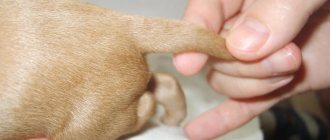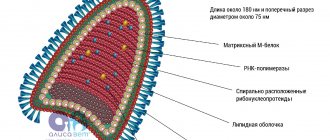Castration of a dog is still a subject of controversy and controversy. Opponents of the operation call the procedure unnatural and cruel. But statistics show that this action is exclusively beneficial for the pet. And more and more owners are resorting to castration not only for medical reasons, but also to correct the dog’s behavior.
Expert opinion
Anna Abramenko
An avid dog lover. Experience in veterinary medicine since 2009.
Ask a Question
In large cities there are organizations of volunteers involved in catching and castrating stray dogs. Thus, concerned citizens are trying to reduce the population of street animals and prevent cases of their aggressive behavior.
Advantages and disadvantages
The main advantage of castration is the reduction in the reproductive capacity of the animal. This action relieves the owner of the need to organize mating and search for a new home for the puppies.
In addition, the advantages include:
- reduction of aggression towards other animals;
- the pet’s character becomes more balanced, its behavior is calm and consistent;
- eliminates the need to mark territory;
- the risk of diabetes mellitus is reduced;
- The possibility of oncological diseases of the genital organs, in particular the testicles or ovaries, is removed.
Surgery has both pros and cons. The latter points include:
- negative effects of general anesthesia, including death;
- increased susceptibility to gaining excess weight;
- There may be problems with the heart or blood vessels.
In addition to the listed risk factors, neutering a male dog can lead to cancer of the genitourinary system.
About castration of a male dog: pros and cons, what age to choose, is it possible not to have surgery
Should a male dog be neutered or not? This is where many dog owners have a negative answer. They assure that there is no point in taking risks by placing an animal under a surgeon’s scalpel. Why subject a dog to such tests by depriving him of a masculine sign, aka:
- not a female and not capable of bearing offspring;
- does not mark the apartment, which makes it different from cats.
Owners of females have to worry about the condition of the uterus and mammary glands, but owners of male dogs seem to have nothing to worry about, and they are not eager to visit a veterinary surgical specialist. But in vain. In some cases, it is necessary to castrate a dog for therapeutic reasons.
Let's find out why veterinary surgeons have to deprive your male dog of his male “household”. And this is not because of the thirst for profit of doctors. With regard to the well-being of the pet, castration of a male dog is characterized by both pros and cons. Only after an independent and thoughtful analysis of all the pros and cons will you be able to, with a clear conscience, come to a decision on carrying out the procedure of castration of the dog and choosing its age for this operation.
Some owners continue to worry that as a result their neutered dog will turn into an “inferior” asexual creature, and other dogs will begin to treat their relatives with contempt. The reason for these conclusions is the humanization of animals, which we all commit to a greater or lesser extent.
It would be nice to know the difference between castrated and non-castrated males. And there is only one thing: the level of testosterone in the blood. This indicator creates both positive and negative in such a procedure.
What we'll talk about here:
1.Six reasons to castrate a male dog.
- Aggression towards other dogs decreases.
- Indoor tagging stops.
- Overexcitement goes away.
- There is no desire to escape.
- There is no threat of infection during accidental mating.
- Performance characteristics are improved.
2. About medical indications: three cases of need to sterilize.
- About oncology.
- About prostatitis.
- About a perineal hernia.
3.About the need for cryptorchid surgery.
4. At what age are males castrated?
5. About the disadvantages of sterilization.
- About the possibility of obesity.
- Why are operations unsafe?
- What complications may follow?
6. Results. For or against?
Six reasons to castrate a male dog
After castration, the pet’s behavioral manifestations change in a positive way. There are many conversations and discussions about the importance of a competent approach to education, but only a few owners attend dog training courses. Inexperienced dog breeders who want to gain company and friendship from their dog, and turn it into a beloved family member, should consider the need for castration as a matter of priority.
1.1. Reduces aggression towards other dogs
Owners of fertile dogs sometimes have to shout to another dog owner from afar - who's with you, girl? Boy? Please stay away from us. And it’s true: castration is recommended if the dog is inclined to start fights with its relatives. This is important if two dogs live in the same area and are in a constant state of showdown.
But it must be taken into account that after the operation other manifestations of aggressiveness will not change in any way. If your dog has a habit of growling at family members or biting strangers, castration will not cure this. The cause of aggression is often not the desire for dominance. On the contrary, aggressiveness hides anxiety, stress, fear, and unsuccessful socialization. Dog handlers, not veterinary surgeons, specialize in solving behavioral problems.
1.2. Indoor tagging stops
Owners of small dogs often encounter the problem of marks. Up to 6 months of age, puppies constantly pee in the house due to emotionality or cannot bear to go outside. A little later, without allowing people to come to their senses and feel relief, the pet reaches puberty. And the young male dog gains strength in purposefully marking with urine places that are important to him in the house. Sometimes shoes, bags, curtains, beds are targeted.
And this is not surprising - this is how nature manifests itself. Watching a dog on the street, you can notice an interest in tree trunks, poles, tires of parked cars: all these are objects of study, after which follows the significant process of lifting his leg - it seems there is nothing to urinate on, but at least a couple of drops should fall!
It is precisely because of the need to continue the race that the need for marking territories arises. Castration eliminates the problem, including among the most seasoned pussies. You just need to wait for changes in hormonal components - a couple of months after the procedure.
1.3. Overexcitement goes away
Hypersexuality should not be discussed in relation to all dogs. But among the male dogs there are those who have nothing else in their minds but the cage. Such dogs can attach themselves to their owner’s feet and to someone else. The owner may find simulated intercourse with a stuffed teddy bear funny, but it should not be ridiculed. Due to the increased content of sex hormones, both the mental and physical condition of the male dog suffer.
After sterilization, the symptoms of an obsessive neurotic state will quickly disappear, the animal has a chance to calm down, when it can take a walk, play with the owner, and communicate with fellow tribesmen.
It is necessary to castrate a male when keeping him in the same house with fertile females.
1.4. No desire to escape
The problem for those who own intact dogs is the presence of a predisposition to escape. Smelling the scent of a female in heat, the pet digs under the dacha fence or breaks the leash during a walk.
By becoming a participant in “dog weddings,” your pet is in danger of getting lost. Males have to get into fights, they can be run over by a car, they can eat harmful or poisoned food in the trash. The owners will never understand the reason for the dog’s non-return: maybe he was picked up by new owners, or he could have died, and how did this happen?
Among non-castrated animals, cases of escapes and losses occur many times more.
1.5. There is no threat of infection during accidental matings
Dogs are not susceptible to infectious diseases transmitted through sexual contact. But there are two frightening features. The case concerns venereal (transmissible) sarcoma, an exclusive disease found among canines. This malignant formation is transmitted through sexual intercourse. The appearance of sarcoma on the genital organ can be indicated by blood appearing after emptying the bladder. Here you need to treat with chemotherapy. If time is lost, the tumor may metastasize.
Another danger is infection with brucellosis. Not very long ago, this disease was rarely recorded among dogs; it applied to cows, goats, and sheep. But over time, dogs with brucellosis often began to be identified. In male dogs, signs of the disease are inflamed testicles and joint lesions. It is impossible to completely cure the animal; it is recommended to castrate and treat with shocking course doses of antibiotics. As a result of crazy matings with stray dogs, infection occurs.
1.6. Improved performance
If your dog lives with you as more than just a pet, he needs to be neutered so that he can concentrate for work. Without this procedure, the dog will not be allowed to work as a guide dog. It is not uncommon to perform operations among hunting dogs: this will in no way weaken the sense of smell and the mood for hunting. There are also indications for surgery for dogs running in sleds.
About medical indications: three cases of need to sterilize
Opponents of sterilization argue their position by the fact that the body does not contain anything unnecessary. This is true. But in nature, canines live up to 6-8 years of age. And pets are much larger, up to 10-16 years old. And during their lifetime, most of them develop diseases of the seminal glands. The only cure and the only prevention is castration.
2.1. About oncology
Testicular tumors are traditional for older males over 7-8 years of age. There are several types of testicular tumors:
1. Sertolioma
The growth is formed by Sertoli cells. It produces estrogens - female sex hormones. This “feminization” is distinguished by the following manifestations:
- symmetrical baldness on the sides, neck, armpits; but the animal does not itch, there are no inflamed areas or scratches;
- the skin becomes thinner and darker;
- the dog can attract the sexual attention of other males, but is not active in the presence of a female in heat;
- a decrease in the genital organ is observed, sagging of the skin of the prepuce is recorded.
The tricky thing about cancer is that the testicle does not always enlarge. Not every veterinarian will be able to prove to the owner that surgery and the following histological analyzes of the removed organ are necessary. In such situations, you can prove it by performing an ultrasound of the testicles and determining the hormonal level.
2. Seminoma
This formation occurs on the epithelium of the vas deferens. The typical age of appearance of the neoplasm is ten years. The growth may appear benign; metastases develop infrequently. But the size is growing at an accelerated pace, and quick surgical help is needed.
3. Leydigoma
With such growth, testosterone production increases to a hurricane level. As a result, the prostate grows and a bubble appears near the anus. Leydig cell formation can be either benign (adenoma) or malignant (adenocarcinoma).
2.2. About prostatitis
Prostatitis is diagnosed in unsterilized males after 5-7 years of age. Benign prostate tumors in dogs are often overlooked. And with advanced prostatitis, difficulties appear in the process of urination and defecation. If you have a prostate infection, the urine contains purulent or bloody inclusions. A stable frequency of mating will prevent stagnation in the prostate, but mating cannot be ensured for life.
Treatment of prostate adenoma or bacterial prostatitis is carried out by surgical or chemical castration. A decrease in testosterone leads to almost complete atrophy of the organ within 3 months after the procedure.
The greatest threat comes from prostate adenocarcinoma, a malignant tumor. It is almost impossible to treat here. Not every veterinary surgeon can remove the prostate completely and then reconstruct the urethra. But even such a labor-intensive operation does not guarantee protection against the development of metastases.
2.3. About perineal hernia
If the owner does not act in a situation of constant enlargement of the prostate, a perineal hernia develops. The huge gland puts pressure on the intestines. To defecate, the animal has to push hard. Then the weakened muscles of the perineum have a way out - to crawl away, and the organs of the pelvic cavity - to fall into the subcutaneous hernial sac, which takes the form of a large tumor near the anus. In the hernia you can find the prostate, bladder, and intestinal loops. If any organ is pinched, the dog faces death.
In the process of repairing a perineal hernia, surgeons must also perform castration to eliminate the original cause of the disease.
About the need for cryptorchid surgery
Often, owners ask to remove only the undescended testicle, leaving the other one. Supposedly this is a sign of masculinity. But mating is contraindicated for males! And the operation must be performed by removing both testes!
The abdominal cavity is 3-4°C warmer than the scrotum (so that sperm can form correctly). With stable overheating of the testis, it is at risk of malignant tumor formation. In an ordinary dog, seminoma is detected at approximately 10 years of age, in cryptorchid - at 5-6 years of age.
If the testicle is located not in the groin, but in the abdominal cavity, the risk increases significantly. The owner does not notice changes in the size of the testis, and metastases develop. In addition, the testis may twist. A sharp pain syndrome appears, the cause of which the veterinarian may not be able to identify.
On the territory of Russia, procedures for lowering the testis into the scrotum and fixing it in it are illegal. Cryptorhams require castration , and this will not interfere with the dog’s long, fulfilling life.
At what age are males castrated?
There is no specific age for the procedure. Important conditions: young age, state of health, up-to-date vaccinations, absence of parasites, good physical indicators.
Since the second vaccination is given to a puppy at three months of age and later, castration should not be done before 4 months. Yes, in the Russian Federation they do not welcome early sterilization. At 4–6 months, teeth are replaced and bones grow rapidly. The owners are not yet bothered by sexual behavior.
Therefore, the appropriate age for castration is 7–12 months. The testicles are tiny, so the stitch will be small and heal well. For mini dogs, at the same time, under the same anesthesia, baby teeth that have not changed by this time can be removed.
Males at 1.5–4 years of age are often brought in for castration. By this time, the prospects of becoming a producer and the need to correct behavior have already been determined. There are no upper age limits. Elderly male dogs undergo surgery for medical reasons.
Abdominal cryptorchids are advised to be castrated early. The owners seem to intend to perform an ultrasound scan of the “hidden” testicle every six months, but they often do not do this. And by the age of 4, the risk of cancer increases. Why such a risk?
With both testes descended into the scrotum, from the age of 4-5 years, a male dog needs to have an ultrasound scan of the prostate. And the procedure for castrating a dog is indicated when congestive prostatitis is first diagnosed.
About the disadvantages of sterilization
If people had a guarantee of the positive consequences of surgery, it would be done more often. Sterilization of dogs does not have a negative effect. But there is something to think about.
5.1. About the possibility of obesity
After the operation, the formation of the male sex hormone (testosterone) is reduced - a strong fat burner, metabolism accelerator and driver of muscle development, not fat. As a result, the animal's susceptibility to obesity increases. In addition, the dog ceases to be interested in bitches and refuses food. He doesn’t watch someone else’s home for days, where the “lady of his heart” lives.
You can often find plump, uncastrated male dogs. And much more often – slender, active dogs that have undergone sterilization. And there is no secret in this: fat is not formed from nothing! You just need to feed your pet rationally so that the operation does not affect its weight.
The reason for the obesity of castrated males is the same as for fertile ones. People feel sorry for the dog, they feed the dog treats, don’t play with it, don’t take it for walks.
5.2. Why are operations unsafe?
Do not believe your veterinarian's claims that castration is completely safe. The procedure uses general anesthesia, which is already risky. Errors in the process also occur: bleeding may begin if the clamp comes off the vessel.
Dogs with poor blood clotting are at risk. Hereditary diseases can lead to significant blood loss. If the breed is considered at risk (Bernese Mountain Dogs), it is necessary to undergo genetic testing before surgery.
The dog is first examined and examined. For young male dogs the following is provided:
- ECG;
- clinical blood test;
- blood clotting analysis.
For older animals, the list can be supplemented by a doctor:
- ECHO of the heart (this is not a replacement for an ECG);
- blood test for biochemistry;
- Ultrasound of the abdominal cavity, kidneys, prostate.
The dangers of anesthesia are increased for brachycephalics.
The owner should be aware of the existence of operational risks - not for fear, but for proper preparation and smart choice of doctor.
There are no single contraindications to castration. If the owner refers to the pet's age, this is not a reason to refuse surgery. If castration is necessary for medical reasons, and the animal has serious heart or kidney failure, Suprelorin is used, a chip containing hormones injected under the skin to block the functioning of the testes.
5.3. What complications may follow?
Castration is not an abdominal procedure (unless the dog is a ventral cryptorchid). There are almost no consequences, except for the most common problems:
- suture inflammation, dehiscence;
- severe swelling of the scrotum.
They are always caused by poor operating techniques or improper care during recovery.
Results. For or against?
The positive impact of castration on the health and behavioral characteristics of a male dog is undeniable. The benefit for people is in improving the working qualities of the animal, be it search, hunting, companion, or harness. The animal is guaranteed a calm, contented life as an “eternal puppy.”
And the facts are stubborn, it is difficult to contradict them - sterilized animals have a longer period of existence compared to fertile ones. As an addition to what has been said, let us remember the problem of “overreproduction” of the countless number of stray, stray, and abandoned dogs. Yes, it is definitely necessary to castrate males who are not breeding breeders.
But we must not forget about the individual approach. In each situation, it is necessary to consult with a veterinarian in whom you have confidence regarding the positive and negative aspects of the dog castration procedure. By way of clarification: if you own a Molosser dog with a loose structure, whose average life expectancy does not exceed 8-9 years, and whose character is phlegmatic, would a veterinarian advise castrating such a dog for prevention? No. Newfoundlands, St. Bernards, Bordeaux dogs, among others. If your active dog is a decorative breed, then definitely yes, it is recommended that the dog be sterilized before marks appear in the home and difficulties with behavior appear. For other situations, you should have your own clear understanding of the purpose of sterilizing your pet.
Suitable age for castration
It is better to send dogs for an unpleasant procedure no earlier than they reach puberty.
It is recommended to remove reproductive organs before the onset of estrus in females or the appearance of persistent sexual desire in males. In this way, you can prevent the desire to mark the territory. In dogs, such actions easily turn into a stable habit, which is not easy to get rid of.
To perform surgery for medical reasons, the age of the animal does not matter. But in order to castrate a healthy dog, you need to take into account several nuances:
- small breeds weighing up to 10 kg begin to look at the opposite sex at the age of 5 to 8 months, it is at this time that you should think about castration;
- medium-sized animals reach fertility between 8 and 12 months;
- Large dogs are taken for surgery at 2 years of age.
It is important to understand that an adult, sexually mature dog, for example, at 5 years old, has already established habits and formed a character. It will not be possible to correct behavioral characteristics using this method.
Also, do not perform the operation too early. This creates an additional risk of developing diseases of the genitourinary system in the puppy.
Spaying a bitch
Having studied the features of surgical intervention in the male body, you can figure out at what age and how exactly dogs are sterilized. The owners of four-legged pets are more savvy in this matter because of their interest: they are the ones who have to tinker with the puppies in the event of an unplanned mating.
Positive and negative points
The main benefits of sterilizing dogs are stopping estrus and reducing the risk of developing cancer. A sterilized pet becomes calmer, easier to train, and its working qualities improve.
The second weighty argument is that the dog will not run away during walks, and after running away it will not bring puppies of an unknown breed. The absence of heat will have a positive effect on her health and behavior.
The disadvantage is similar to the operation for males - it is excess weight. To control body weight, veterinarians recommend switching to lower-calorie food and reducing the daily portion.
Optimal age
It is better to find out at what age to sterilize a dog from a veterinarian. Most are inclined to believe that the optimal age is 2-3 weeks before the first heat, when the likelihood of hormonal imbalances and breast cancer is minimal.
Immediately after estrus and especially after childbirth, the hormonal balance changes. Every year, an unsterilized pet is at greater risk of developing cancer.
There is also a limit on the upper threshold. After 6-9 years, depending on the breed, animals tolerate anesthesia less well, which increases operational risks. At this age, surgery is performed only for medical reasons.
Medical indications and contraindications
Veterinarians recommend sterilizing breeding animals at 6 years of age, after their last pregnancy. Thanks to constant pregnancies, their hormonal levels are more stable than those of nulliparous women, so the risk of developing cancer increases only after the cessation of labor.
Medical indications also include excessive and prolonged estrus, which worsens the quality of life of the bitch, as well as frequent false pregnancies, which can lead to the development of mastitis.
It is dangerous to interfere with the body of a pregnant female at a late stage or in the presence of blood clotting disorders, heart disease and lung pathology.
Intervention methods
There are 2 main techniques: abdominal and laparoscopic. In the first, excision is carried out in the classical way using a scalpel, and in the second - using a laparoscope, that is, a thin endoscope for manipulating the abdominal cavity.
With the cavity technique, the procedure is carried out in 3 ways:
- ligate the fallopian tubes, leaving the uterus and ovaries, which preserves sexual desire;
- removal of the ovaries (oophorectomy);
- The ovaries are amputated along with the uterus (ovariohysterectomy).
Laparoscopic methods are performed in similar ways, but are considered more gentle. Thanks to a small puncture, less blood loss is achieved, which reduces surgical risks and shortens the postoperative period. The only negative is the complexity of the technique. Not all clinics have expensive equipment and doctors who know how to operate it.
Possible complications
In the postoperative period, one-time vomiting, loss of appetite and a temporary increase in temperature may occur. These symptoms go away on their own within the first two days. More serious complications include:
- internal bleeding, accompanied by the appearance of compaction or redness in the suture area;
- repeated vomiting;
- infection of the suture, leading to its swelling and bleeding mixed with pus;
- maintaining a high temperature for more than 2 days.
If the procedure is carried out incorrectly, estrus may resume. In this case, the intervention is repeated.
Estrus, pregnancy and childbirth
If the animal does not suffer from prolonged estrus, then it is operated on 2 weeks before or after estrus. The rest of the time there remains a high probability of heavy blood loss due to vasodilation.
During pregnancy, surgery is performed only in the first month after mating. At later stages, a pregnant female is allowed to undergo the procedure only if there is a threat to her life or abnormal development of the fetus.
After giving birth, veterinarians recommend waiting 2-3 months for the body to fully recover. This time is necessary to normalize blood circulation in the pelvis and return the usual size of the uterus. Exceptions include postpartum hemorrhage, placental damage, uterine rupture, and neoplasms in the reproductive organs. In these cases, the possible risks of intervention are considered justified.
Indications and contraindications
Before deciding to castrate your male dog, it is recommended that you familiarize yourself with the possible consequences. An important aspect is the health of the pet. Therefore, before surgery, the dog is thoroughly examined, which helps to identify possible risks.
Indications for castration of an animal include the following factors:
- reduction of sexual desire to improve the working qualities of hunting dogs and dogs used for protection;
- elimination of reproductive functions and their consequences in the form of unwanted offspring;
- medical indications, primarily neoplasms on the organs being removed;
- decreased level of dominance and aggression in males;
- troubleshooting problems with territory tags;
- correction of behavior in animals of both sexes.
Contraindications include:
- kidney disease;
- problems with blood vessels or heart;
- not reaching puberty;
- exhaustion or dystrophy;
- period of scheduled vaccination.
From a medical point of view, castration is possible until the dog reaches adulthood. But there is meaning in surgery on an adult male dog only in the case of specific diseases.
Difference between castration and sterilization
Few owners and even breeders understand the difference between these actions.
Castration of dogs is a surgical procedure performed under general anesthesia to remove the reproductive glands in males or the ovaries in females.
Sterilization is a surgical intervention performed under general anesthesia to impair reproductive ability. The essence of sterilization is the blocking of the seminal flows or fallopian tubes in dogs, which results in the cessation of the production of sex hormones and cells. After sterilization, even mating is possible. But the dog will not become pregnant and will not have offspring. Many people believe that castration of dogs occurs exclusively for males, and sterilization is indicated for females. This is not entirely true: sterilization of both sexes differs in that the fallopian tubes are ligated in females, and the seminal ducts in males.
Hurry up, choose a box and find out what gift awaits you
Discount on pet insurance
Promo code copied to clipboard
Preparation
You need to take care of all necessary vaccinations in advance. Vaccination is carried out at least a month before surgery. In addition to this, the pet must be freed from all types of parasites, including worms and ticks.
Do not neglect examining the dog or limit yourself only to an external examination. The pet will undergo serious abdominal surgery under general anesthesia; checking the functioning of the cardiovascular system will not be superfluous. You also need to prepare urine and blood tests.
Immediately before castration, the dog is limited in food for 10 hours and in fluid intake for 6 hours.
How to prepare a dog for castration
The specifics of preparation depend on the age and health of the dog. For mature animals without chronic diseases, special preparation is not required. The pet should stop feeding 10-12 hours before the procedure; a good walk is required immediately before the operation. It is recommended to purchase in advance everything necessary for care after surgery - napkins, a carrier, a collar and an antiseptic solution for treating sutures.
For dogs over 5 years old, diagnostic tests are prescribed before castration to identify contraindications and the degree of risk of anesthesia. As a rule, a general and biochemical blood test, echocardiography and ECG are performed.
How does the operation take place?
The procedure is carried out strictly in a medical institution by doctors of appropriate qualifications. You shouldn’t risk your dog’s health by neutering it at home. An experienced doctor who values his reputation will never agree to such experiments.
The surgical technique used in the surgery involves removing the testicles and ovaries through incisions. To castrate a male dog, a small cut of the scrotum is sufficient. Bitches are less fortunate; their suture is located on the peritoneum. Some clinics practice laparoscopy, where instead of an incision, several punctures are made.
There is an alternative option; special drugs are used for it. The effects of chemical castration wear off after six months. The duration may vary slightly depending on the substances administered. This method does not involve the use of general anesthesia; medications are injected into the subcutaneous layer of the dog.
Clinical examination before surgery
Healthy animals with normal appetite and no digestive disorders are allowed for the procedure. Castration of a dog is considered preventive, which does not exclude a preliminary examination and the preparation of contraindications and recommendations that will have to be taken into account during the surgical intervention and subsequent recovery. If a male dog has diseases that require treatment, castration may be postponed until the contraindication is eliminated.
If the veterinarian suspects the presence of a disease, the dog may need a laboratory test of blood, urine, and ECG.
Before castration, the dog should take an anthelmintic and have all the necessary vaccinations. As a result of the intervention, the immune system will be somewhat weakened, so the body must be guaranteed to be protected from dangerous pathogens. Deworming and vaccinations are mandatory requirements before the procedure.
Activities before anesthesia
Immediately before castration, the animal requires fasting for 8-10 hours. This is due to the fact that the dog has a gag reflex and in a state of artificial sleep can simply choke on vomit. The pet's stomach should be empty.
Limit your dog's access to water for at least 3 hours. Predators are able to go without food for 3-4 days. Even if your pet is not accustomed to food shortages and restrictions, there will be no harm to him. Also, on an empty stomach, the animal tolerates anesthesia more easily and wakes up more easily after it.
The choice of medications is made based on the examination and the patient’s well-being. The doctor selects the dosage of drugs directly for muscle relaxants and anesthesia. Some reduce stress, relax the muscles of the whole body, while others depress the nervous system, causing artificial sleep.
Drugs are administered to dogs in 3 ways:
- Intramuscularly - the most common method;
- Intravenous anesthesia is suitable for large male dogs that have no problems finding veins;
- Inhalation – if the first two methods are not possible.
The administration of painkillers can be combined: for example, inhalation is used first, then drip systems are installed.
Modern anesthesia medications are gentle and eliminate side effects. The pet easily recovers from anesthesia and does not experience long-term discomfort.
Methods
Surgical castration is performed using several methods. Each of them has both pros and cons. The choice depends on the pet owner or medical indications.
- Excision of the testes while preserving the scrotum. This method is the most preferred. It is used in most veterinary clinics.
- Amputation or scrototomy, this operation involves removing the entire scrotum. This method is recommended in cases of tumors appearing in the dog’s genital area.
- Vasectomy or interruption of seminiferous tubules.
The choice of castration method is based on the condition of the animal, which must be assessed by a qualified doctor.
Features of cryptorchid castration
Dogs with pathologies of the location of the testicles suffer from the following ailments:
- the formation of tumors that degenerate into malignant ones;
- inguinal hernia;
- pathologies of the penis and preputial sac;
- prostatitis;
- diabetes.
Animals are aggressive and sexually active. It is necessary to prevent mating, because deformity is inherited.
An undescended testicle may be located in the male dog’s groin or abdominal cavity. In the first case, the surgical technique differs slightly from conventional castration. For subcutaneous localization, the scrotum is cut, the testis is squeezed out, the cord is ligated, and it is cut off. When the testicle is located in the abdominal chamber, abdominal surgery is indispensable.
Removed testicles
Some owners wish to maintain the full appearance of a male. They ask a veterinarian to insert a prosthesis into the dog. Unscrupulous dog handlers hope to receive a positive assessment at the exhibition. After all, a cryptorchid, which has one testicle preserved, is capable of fertilization. Experienced experts have learned to distinguish dummies from real testicles and expose scammers.
Post-operative care
Important factors in rehabilitation after castration are rest and lack of stress.
The dog must be provided with a warm and comfortable place, light food and sufficient clean water. A castrated dog will recover faster if you provide him with comfortable conditions.
Changing bandages deserves special attention. Here, an option is possible with daily trips to the clinic for bandaging, but this will require money and time. Therefore, most owners cope with the task on their own.
During the procedure, the seam is treated with an antiseptic solution, and fresh bandages are applied. It is important that the bandage is not too tight, otherwise the dog will try to rip it off and may harm itself.
Expert opinion
Anna Abramenko
An avid dog lover. Experience in veterinary medicine since 2009.
Ask a Question
It is necessary to carefully monitor the postoperative suture. If pus or blood appears, you should immediately contact a specialist.
At what age should female dogs be spayed?
Again, spaying before six months of age is becoming increasingly common , although there are a number of problems that could potentially be caused by spaying your bitch while she is still very young. As with male dogs, female dogs need to produce growth hormones T3 and T4, which begin to be produced as puberty approaches, as well as estrogen for normal development and hormone regulation. A female dog that is spayed too young does not have the opportunity to begin producing estrogen and other important hormones, which can lead to a number of problems later in life. Urinary incontinence may result from inadequate estrogen production, a condition that cannot be cured and will require continuous estrogen supplementation for the rest of your life; something that is of course not ideal for many reasons. Once your female dog has completed her first season, you should try to have her spayed soon after. This ensures that she has reached sexual maturity before being spayed, and ensures that you can calculate where she is in her estrogen cycle to ensure that she is spayed between cycles. Spaying a female dog in heat or just before the season is much riskier for the female dog, and veterinarians will not spay a female dog in heat unless absolutely necessary. It is commonly believed that a female dog is allowed to have a litter before she is spayed, but in reality there is no good reason for this and your female dog will not benefit from a litter before she is spayed. and ensures that you can calculate where she is in her estrogen cycle to ensure she is sterilized between cycles. Spaying a female dog in heat or just before the season is much riskier for the female dog, and veterinarians will not spay a female dog in heat unless absolutely necessary.
Article Author: Dr. Jordan Turner is a practicing veterinarian who works with dogs and cats. He is also the founder of a personal website that aims to improve the health and welfare of animals by offering trusted, veterinarian-approved information.
Possible complications
Castration is considered a relatively safe operation. Most males tolerate it without consequences. After the procedure, swelling may occur in the incision area. This process is considered a variant of the norm and goes away on its own in a few days.
Since castration in bitches involves an incision in the abdominal cavity, the risk of complications is much higher. First of all, these include abscesses and the formation of foci of pus. The elimination of these unpleasant moments must be entrusted to doctors.
In addition to external signs of complications, such as discharge and persistent swelling, you need to pay attention to the general condition of the dog. High temperature, refusal to eat or apathy are warning signs. In such cases, you cannot do without the advice of professional veterinarians.
Veterinarian advice
Veterinarians agree that castration has a positive effect on a dog’s life expectancy and improves its behavior. Helpful Tips:
- The operation should not be performed before 6 months; you need to wait until puberty begins and get all the necessary vaccinations;
- It is best to choose absorbable threads - no need to remove sutures, making caring for your pet easier;
- The dog should not be bathed or washed before the stitches are removed;
- Sterilization of a pregnant bitch is allowed if this is associated with a threat to the life of the animal or puppies;
- castrated dogs need training and information load; surgery will not make the animal obedient.
In bitches, the uterus is sometimes left in the body. This is dangerous due to subsequent inflammation and the development of pyometra. Even before the operation begins, you need to discuss all aspects of abdominal surgery with your doctor.
Behavior of castrated dogs
Even after parting with the genitals, the dog will not immediately stop feeling attracted to the opposite sex. For psychological adaptation after surgery, time must pass, in some cases up to a year.
Behavioral correction concerns more young dogs. And it is connected not only with the operation, but also with education. An adult dog with already established habits and a fully formed character will not change much after castration.
Many owners notice a decrease in their pet's aggression. Libido really directly affects the character of male dogs, stimulating them to show their authority. Neutering will eliminate this problem, making the dog more balanced.
Behavior after castration
If before castration the dog was active and loved to play, he will remain the same. Behavior after sterilization and castration for the first time does not change in principle. But over time, the benefits become more and more obvious. A dog on a walk stops marking every post and anxiously sniffing every bush. Even a young male dog becomes more calm in his character. The adult bitch also becomes calmer, and the false pregnancy that is common after estrus disappears. But if before the operation the male’s activity was dictated by the search for rivals or a female, then it is worth helping the pet find new motivation. If there are complex behavioral problems that cannot be completely eliminated by castration, the help of a dog handler will be required in correcting behavior. The opinion that after an operation a male or female dog loses its working qualities or becomes lazy is incorrect, which has been proven by examples of many working breeds that continued to perform their functions perfectly even after castration. The owner should load the pet with tasks and work. Let this interaction be reduced to playing a ball or following simple commands: a dog, especially a sterilized one, needs an active phase of life. Veterinarians agree on one thing: the behavior of a neutered dog improves in the direction of a sharp decrease in aggression towards other dogs.
Reviews
Oksana Zelenova, Novosibirsk: “I have a male Rex toy terrier breed. At the age of six months he began marking the apartment. The smell was indescribable. The dog was scolded, punished, everything was useless. Not castrated yet. From that moment on, my charming animal brings only joy.”
Kirill Matveev, Moscow: “I chose a Pomeranian Spitz dog from a specialized kennel with a good reputation. I checked all the documents, vaccinations, pedigree. But after a while I began to notice the dog having convulsions. The clinic diagnosed cryptorchidism. After castration, the problem disappeared.”
Semyon Ivanov, Voronezh: “I am the owner of a German shepherd named Ada. Before castration, the dog actually attacked people. It got to the point that no one in the family except me came into her enclosure. Castration actually corrected the situation; the animal reacts more calmly even to strangers.”
Castration is the most humane and modern way to prevent the birth of unwanted offspring. Dogs that are not intended to be adopted can cause a lot of trouble for their owners. This procedure will help maintain your pet’s health and improve its character.
What to expect
Knowledge is power, and it pays to know what to expect when you have your dog neutered.
The veterinarian carries out the procedure himself. Sterilization is a routine operation that is very safe. The incidence of complications after surgery is low, and the vast majority of dogs recover quickly and without any problems. The procedure is performed under general anesthesia, so your dog sleeps and does not feel anything.
Neutering is usually done within one day, so your dog will usually go home the same day.
There are a few things you will need to do differently while your pet is recovering from surgery.
© shutterstock
Pros and cons of the procedure
To answer the question whether dog castration is yes or no, you need to consider its advantages and disadvantages.
The benefits of the operation are as follows:
- decreased susceptibility to various diseases;
- lack of tags in the apartment;
- reducing the desire to escape, and therefore the risk of getting run over by cars;
- less frequency of fights with relatives.
In addition to its beneficial effect on behavior, the operation acts as a preventive measure against many ailments that occur due to high levels of hormones:
- Malignant tumors, cardiovascular pathologies.
- Prostatitis.
- Diseases of the adrenal glands, kidneys, thyroid gland.
- Disruption of the gastrointestinal tract.
- Diabetes.
Surgery may be required for pathologies of the genital organs (spermiferous tubules, scrotum). After it, the pet recovers. The readings are not affected by breed.
The main harm of surgical intervention is considered to be an increase in the risk of certain diseases:
- bone cancer;
- hypothyroidism;
- hemangiosarcoma;
- urinary tract and prostate cancer.
Urinary incontinence after castration is uncommon. It is easier to regulate with hormonal agents than complications after sterilization.
Many of the disadvantages of the operation are myths. For example, a decrease in working qualities. At the same time, castrated sled dogs are not inferior in activity and size to leaders.
Some owners notice that the dog's character is changing. Drowsiness, passivity, and apathy appear. In fact, there are no changes in behavior, except for the desire to mate and aggressiveness. If the dog has gained weight, this indicates that it is not eating properly.
Positive points
Doctors note that:
- Problematic male dogs, whose behavior was caused by high hormonal levels, will be much more receptive to training, since they are not distracted by females in heat and follow commands more “thoughtfully.”
- The dog will stop running away from home and it will become easier to walk with him.
- Your pet's temperament will not change. If he was active and playful, he will remain so.
- Neutered dog breeds live a little longer and are less stressed during their lives, which is associated with searching for and fighting for a female in heat.
- The risk of developing testicular cancer and death from this disease is completely eliminated.
- The risk of developing prostate lesions is reduced - we are faced with medical indications for castration of a male dog so that the dog can urinate normally and go to the toilet in large quantities. Hormonal levels affect the prostate gland, which increases in size and this is prostatic hyperplasia.
- Hunting dog breeds have long been neutered for productive hunting. It has long been proven that this does not affect ardor and excitement in any way, and the fact that the dog will not be distracted by a female in heat is only a plus.
- Castration of small breed dogs is a simple operation, not much more complicated than, for example, castration of a cat. This is a planned operation, so you will know the exact date and time. On this day, it is usually not recommended to feed your pet heavily, and you definitely should not do this just before leaving for the clinic.
- Since the operation is performed under general anesthesia, your pet will not feel anything and will sleep peacefully. Don't be alarmed if his eyes are open while under anesthesia; there's nothing wrong with that.
What negative consequences can your pet expect after and during castration?
- The dog will suffer from obesity, this is fundamentally wrong. Overfeeding mainly leads to excess weight. To choose a diet due to decreased energy expenditure on searching for females, contact your veterinarian, and your pet will be in great shape.
- The dog may vomit with a full stomach during anesthesia, but this is less scary than if vomiting occurs during surgery. Firstly, the sterility and cleanliness of the surgical field may suffer, and secondly, vomit may enter the trachea and make breathing difficult.
- This includes risks during anesthesia. Although the operation is simple, we recommend that you consult a veterinarian you trust. If your pet is completely healthy, then you have nothing to worry about.
- The dog will suffer from obesity, this is fundamentally wrong. Overfeeding mainly leads to excess weight. To choose a diet due to decreased energy expenditure on searching for females, contact your veterinarian, and your pet will be in great shape.
- The dog may vomit with a full stomach during anesthesia, but this is less scary than if vomiting occurs during surgery. Firstly, the sterility and cleanliness of the surgical field may suffer, and secondly, vomit may enter the trachea and make breathing difficult.
- This includes risks during anesthesia. Although the operation is simple, we recommend that you consult a veterinarian you trust. If your pet is completely healthy, then you have nothing to worry about.
Optimal age for sterilizing an animal
Selecting the age for sterilizing a dog is quite difficult, since it may depend on a combination of several factors. But the following age periods can be distinguished:
- From 6 months to 1 year. Many veterinarians consider this time to be the most optimal. But it must be remembered that representatives of large breeds must be operated on when they are at least a year old. The body of these animals develops more slowly, and therefore they have to wait longer. Large dogs that are spayed as early as possible grow very large (even though they are already quite large). This anomaly is due to the fact that with early depletion, the growth zones on the bones close late, and therefore the growth period lasts longer.
- From 1 year to 3 years. The most common option. The pet's body tolerates the operation very well, the postoperative period is quite short.
- Up to 5 years. The animal’s body still tolerates the effects of surgery well and recovers quickly. But still, many veterinarians are wary of the idea of operating on five-year-old dogs (especially large breeds). It is already difficult to say how well their body will tolerate the removal of reproductive organs.
Indications for use
The operation is not performed on all animals without exception. It depends on the physical form, the level of hormonal substances in the body and the breed of the dog. It is advisable to make a decision in favor of surgical intervention together with a qualified veterinary specialist, who will help to avoid complications associated with the individual characteristics of the animal.
The main indications for castration in dogs of both sexes:
- Improving the working qualities of dogs - a dog used to guard territory or as a sled dog, as well as a guide dog, are castrated, allowing one to eliminate sexual desire and better concentrate on work.
- Uncontrolled reproduction - when keeping a female individual, there is a high probability of uncontrolled conception and the production of a large number of puppies. Removing the reproductive function will avoid unwanted offspring.
- Complications in the health of the animal - removal of the gonads in dogs requires such anomalies as cryptorchidism, as well as ailments (malignant neoplasms on the testicles and ovaries, cysts and prostatitis).
- Elimination of behavioral problems - castration of a male dog is carried out in case of groundless ejaculation and unmotivated aggression. In most cases, disturbances in the behavior of dogs are observed due to an excess of male sex hormones. After castration, the dog becomes more obedient, aggression disappears, and the need to establish the leadership qualities of the leader disappears as unnecessary.
Which dogs do doctors recommend neutering?
These are aggressive breeds that do not follow commands, rush at dogs, people, and their owners are ready to take more desperate steps in the form of euthanasia.
Service and hunting breeds that are not valuable for breeding and castration will improve their service qualities.
Take the Attention Test! Find 10 differences! (click right here!)
Find the answer Are you bothered by some problem or question? Enter “Breed” or “Name of the problem” into the form, press Enter and you will find out everything about the issue that interests you.
Dogs with genetically transmitted diseases: hip dysplasia, cardiomyopathy, hemivertebra and many others, characteristic of each dog breed. Castration will allow you to develop a healthier breed over time and not cause trouble to future owners.
At the same time, you should not castrate a dog just so that it becomes more obedient, more affectionate and falls in love with a drunk neighbor. This will not make any sense when reproduction is not in the first place. Dogs are pack animals, and the most dexterous and strong ones can reproduce in a pack, the rest have their own functions. They should not be confused with cats, which are solitary by nature and the craving for the fair feline sex overshadows other desires.
On average, by 9 months, males will be sexually mature and you can think about castration.











